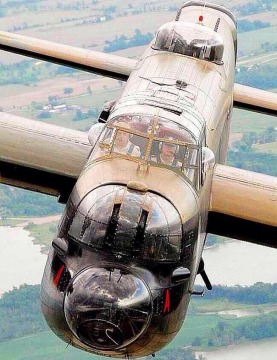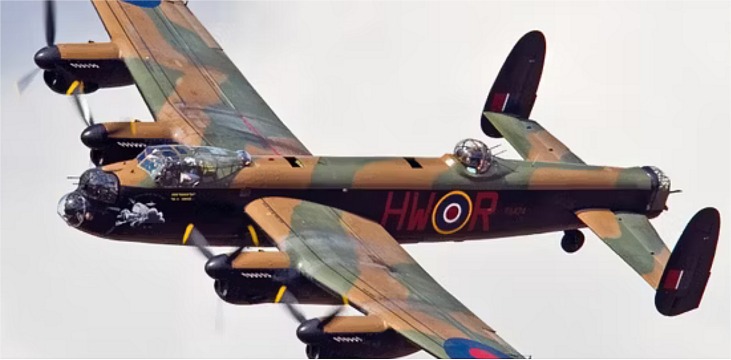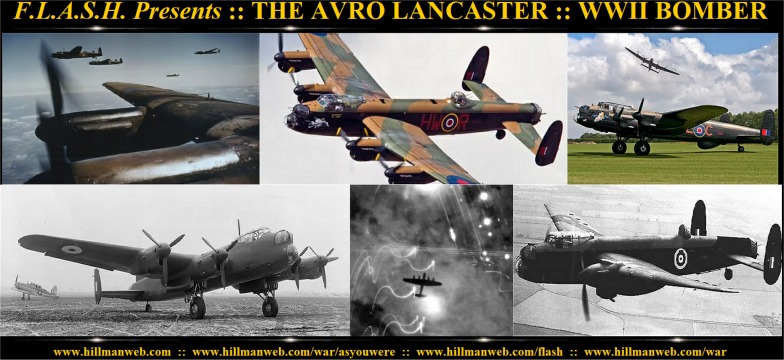Bill Hillman's Monthly Military Tribute
F.L.A.S.H.
Forces ~ Land ~ Air ~ Sea ~ Home
www.hillmanweb.com/flash
AS YOU WERE . . .
WAR YEARS ECLECTICA :: AUGUST 2023a
JOIN OUR FACEBOOK GROUP HERE
2023.08a Edition
This Is What Made The Avro Lancaster
Such A Successful WWII Bomber
Ref: Military Aircraft Blog ~ August 23, 2023

The Lancaster became a British icon of the conflict, and to this day, one is still flown by the RAF.
The Second World War was an absolutely fascinating time for military aviation technology. Both the Allied and Axis forces were constantly pushing the boundaries of each other to see who could come out on top. This gave such aircraft as the Supermarine Spitfire, the Messerschmitt Me 262 and the P-51 Mustang. All these aircraft were technological marvels of the time, but it wasn’t just fighters where this technological might was on show. It was on show in the bomber world as well. Especially when it came to the British.In the bomber world, the American mainstays were the B-24 Liberator and B-17 Flying Fortress. America would bomb Germany by day, whilst the British would do so by night. The British had three main heavy bombers. There was the Handley Page Halifax, the Short Stirling and the Avro Lancaster. It was the Lancaster that would earn the most fame and success, and it quickly became one of the most successful bombers of the Second World War. Even now, a pair of these aircraft are flying to this day, and all survivors serve as memorials to the brave men that flew in them.
The Development Of The Lancaster
The origins of the Lancaster are rather interesting. In the mid 1930s, the Royal Air Force was looking for a new, twin-engine bomber. This would be formed from Air Ministry Specification P.13/36. The Avro company, led by famed designer Roy Chadwick, came up with the Manchester. A twin-engine heavy bomber that was introduced into RAF service in November 1940. A capable aircraft, it was soon found to be under powered and sadly unreliable, thanks to its Rolls-Royce Vulture engines. The Manchester would be retired in 1942 after barely two years in service. But Avro’s efforts with the aircraft would not be in vain.Even as the Manchester entered service, Chadwick and Avro were working on an improved version. This would be a four-engine aircraft, powered by the Rolls-Royce Merlin engine that was famous for its use in the Spitfire and de Havilland Mosquito. The Merlin was less powerful than the Vulture, but much more reliable. Essentially, the Manchester have evolved into the Lancaster, and the huge four-engine leviathan first took to the skies in January 1941. It had a crew of 7, and a maximum speed of 282 mph with a range of 2,530 miles. And it could carry up to 14,000 lb worth of bombs. A staggering amount at the time.
The Lancaster In British Service
The Lancaster would soon prove its worth in service. The first operational mission for the Lancaster would be in March 1942, deploying naval mines in the vicinity of Heligoland Bight. Its first bombing mission would be over the German city of Essen. The finest hour for the aircraft though came in the 1943 “Dam Buster” raids by 617 Squadron, officially called Operation Chastise, with the incredible bouncing bomb designed by Barnes Wallis. This saw a fleet of Lancaster MK IIIs fly at ultra low-level to destroy the dams in the Ruhr Valley. Of the three dams, two were breached, and one was damagedIn the latter half of 1944, 617 Squadron was again part of a high-profile raid, alongside 9 Squadron, to attack the German battleship Tirpitz as it lay in a Norwegian fjord. Three attacks were conducted against the ship, Operations Paravane, Obviate and Catechism. The first operation disabled the ship, whilst the final one finally sank the battleship. This raid helped cement 617 Squadron’s place as the most famous of all Lancaster squadrons. The Lancaster would remain in service beyond the end of the war, as a bomber, coastal patrol aircraft, transporter and it even evolved into the more advanced Lincoln. Lancaster’s were even used in the Berlin Airlift as tanker aircraft.
The Lancaster In The 21st Century
The Lancaster became a British icon of the conflict, and to this day, one is still flown by the RAF. This is PA474, flown by the Battle of Britain Memorial Flight, that also consists of Spitfires and Hawker Hurricanes, and they are regularly seen at airshows across the UK and beyond. A second aircraft, FM213, is airworthy in Canada, with a third, NX611, being slowly restored to airworthy status in Lincolnshire, England. A total of 17 intact Lancasters remain, and all serve as tributes to the brave pilots, from all over the world, who flew them.
One Of The War's Most Incredible Aircraft
The Lancaster had quite humble beginnings in the form of the Manchester, but it became one of the most recognizable and most dependable aircraft the British had in World War 2. That it was able to be used in other roles too even after the war was over, shows the versatility the Lancaster had. Remarkably, just ten years after the Lancaster entered service, Avro would go on to produce the Vulcan. That aircraft showed just how fast aviation technology had progressed, with lessons learned from one of the most recognizable bombers of World War 2.


Click for full-size promo splash bar
As You Were . . .
F.L.A.S.H.: Forces ~ Land ~ Air ~ Sea ~ Home
VISIT THE HILLMAN MILITARY TRIBUTES F.L.A.S.H.
As You Were . . .
Military TributesNavigation Chart to the
Hillman WWII Tributes
www.hillmanweb.com/warShort Bursts
Ex-Air Gunners Association
Magazines

Webmaster: William G. Hillman
BILL & SUE-ON HILLMAN ECLECTIC STUDIO
Editor and Webmaster Bill Hillman ~ Copyright 1999-2023